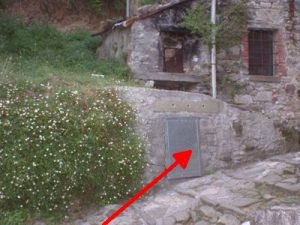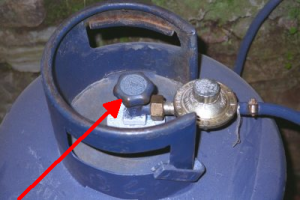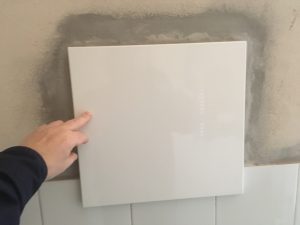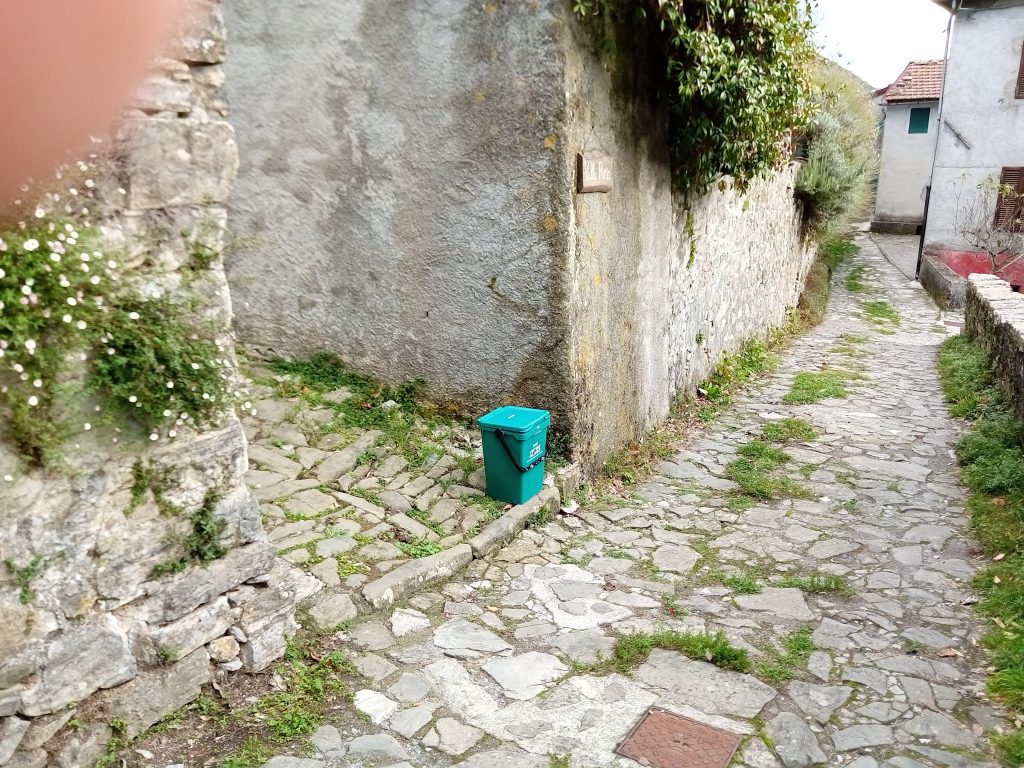WATER:
The tap water is of good quality, and is suitable for drinking.
The main water valve is normally closed by arrival. The valve is found outside, at the opposite end of the courtyard (on the top of the road) in a cabinet marked GAS (see picture). The key to the cabinet – a small square key – is hanging on the front door of the kitchen. At the far right in the cabinet there is a lever which is 90° to the water pipe when it is closed. To open the water, twist it 90°, until it is parrallell to the tube.The round crane wheels should not be touched!
Remember to close the valve again when you leave!
WATER HEATER:
The water heater (underneath the stairs) is heated by the central heating stove whenever this is in use. If the stove is not used, the heater can use electirical power – there is a switch next to the electrical outlet for the washing machine. A red light on the boiler will light up (it is on the back of the boiler, facing the wall) when electric heating is turned on and active.
WASHING MACHINE:
There is a separate stopcock for the washing machine, right behind it. This should be closed upon arrival and departure. Be sure to open this before using the washing machine. When finished washing, close the valve and unplug the cable.
GAS:
There is a valve for the gas at the gas bottle in the small “gas house” at the end of the alley in front of the house (just outside the bathroom). Open the valve (see picture) before use, and close it again before you leave. The pressure reducing valve next to the gas cylinder should normally not be touched! The key to the padlock on the gas house also hangs on the kitchen door (currently the padlock is not used).
In the kitchen there is a stopcock for gas, which can be shut at night if this makes you feel safer. It is yellow and is found in the cabinet below the sink. Note that this may be shut at your arrival!
Upon arrival there should always be an unopened 15-kilo cylinder in addition to the one in use. If you need to change the gas cylinder, please note that the flange on the gas bottles are threaded “links”.
COOKER:
Features four gas burners and an electric oven.
The gas burners are self-igniting and equipped with a safety device, preventing gas leakage. To light the burner, the knob is pressed slightly to engage the automatic ignition turned up to the max (turn counter-clockwise) and the flame is lit. The flame is reduced by turning the knob further counter-clockwise, and turned off by turning back the knob to the starting position (straight up).
THE STOVE (CENTRAL HEATING):
The fully automatic central heating stove, mounted inside the old fireplace in the kitchen, operates on wood pellets. It supplies energy to the water heater, the bathroom floor, the towel rail and radiators on each of the bedrooms, the lounge and the hall. It also gives some direct heat in the kitchen area.
The operating panel and pellet hopper inlet is situated at the bathroom, just inside the door. Press lightly on the left side of the hopper cover to open it.
Turning it on:
- Ensure the pellet hopper is adequately filled up with high quality pellets.
- Turn the main switch (rocker switch) to “1”.
- Startup messages should display for a few moments. Check that no alarm messages are displayed.
- After the startup procedure is successfully finished, the ignition process will follow. It will take a few minutes until the flames can be enjoyed in the kitchen.
- The stove will burn until all heat consumers (water heater, radiators…) are satisfied. It will then extinguish until needed again. It will remain off between 23:00 and 06:00.
Daily use:
Fill the hopper with pellets as needed. The brass cole bucket found in the kitchen can be used for filling. Consumption varies with outdoor temperature, the number of rooms that are heated and the shower frequency. In the winter time 15-30 kg per day, in the summer maybe only 5 kg or less.
After approx. 50 kg of pellets are used, the ashes should be removed from the burning chamber:
- Extinguish and turn off the stove as explained below.
- Let cool down for about an hour.
- Open the glass front cover.
- Remove the ash pan, and empty it into a firesafe (metal) bucket.
- Remove and clean the brazier using the vacuum cleaner or a brush.
- Hoover inside and outside the stove to remove any spills of ash.
- You might also want to clean the inside of the front cover glass, using ordinary window detergent and some paper, to get a better sight of the fire (for as long as it lasts).
- Finally, reinsert all parts, close the front cover and turn on the stove as explained above.
Turning it off:
If the fire is lit, extinguish it:
Open the control panel cover, press any key to activate the display. The message ON should flash/alternate with some other message. Press the ![]() button until the message changes to POWER OFF. Wait for the stove to extinguish.
button until the message changes to POWER OFF. Wait for the stove to extinguish.
If the fire is not lit, but the fan can be heard running, find out what is going on:
Open the control panel cover, press any key to activate the display. If the message POWER OFF is displayed (flashing/alternating with some other message), just wait for the fan to turn off. If the message displayed is WARMING UP, the stove is igniting. Press the ![]() button until the message changes to POWER OFF. Wait for the fan to turn off.
button until the message changes to POWER OFF. Wait for the fan to turn off.
When the fire is out and the fan is silent, turn the main switch (rocker switch) to “0”. Don’t forget to empty the ashes and clean the glass 😉
ELECTRICITY:
The main power fuse is located in the hallway, just inside the front door. The white meter/fuse appliance is ours. Other fuses are above the kitchen door. There are three fuses: Kitchen/Lounge (16A), Bathroom (16A) and upper floor (10A).
The main fuse can withstand in excess of 3 kilowatts. It is easily overloaded, for instance when using the dishwasher and other appliances at the same time. Be careful to balance the load if you want to avoid this!
TELEPHONE:
There is adequate mobile phone connectivity in the area, but at times it can be necessary to go outside to make a conversation or send text messages.
WIFI/INTERNET:
There is wireless internet in the house. This is based on a hybrid link line (optical/copper), and the bandwidth is “up to 100 Mbps”, usually a little less. For most everyday purposes it is more than sufficient.
The wireless router is located on top of the kitchen cabinets, and best connection is achieved in the kitchen/lounge area, even though you can connect anywhere in the house as well as in the courtyard.
The network name is Loc. Cocolaio 125, and the password is Benvenuto! (including the exclamation mark).
WASTE:
Waste is sorted in five different categories, into containers or bags found in the corridor outside the kitchen. There are separate containers for glass bottles (green), paper and cardbord (white), and organic waste (brown). Plastic and metal emballage is sorted in yellow plastic bags, and waht is left is considered general waste and put into gray plastic bags.
The organic waste should be put in organic bags (also found in the corridor) before it is disposed in the container. There is a small pedal bucket in the cupboard below the sink to hold an organic bag.
Waste is collected at the base of the alley to the courtyard, six days a week:
- Monday: Organic waste (brown container)
- Tuesday: Glass bottles (green container)
- Wedensday: Plastic and metal (yellow bag)
- Thursday: Organic waste (brown container)
- Friday: Paper and cardboard (white container)
- Saturday: General waste (gray bag)
The waste should be brought to the collection point the evening before.






